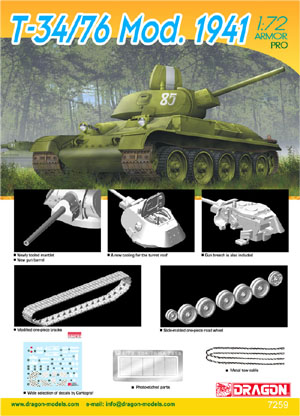| |
Dragon T-34/76 Mod. 1941 (7259)
by Frank De Sisto
1/72nd-scale injection-molded styrene kit containing 92 plastic parts,
two lengths of DS100 tracks, one photo-etched brass part, one piece of
wire, 15 decal/markings options and four pages of instructions in seven
steps.

DML have followed their T-34 Model 1940 kit with the Model 1941. While
it is not a drastic leap from one kit to the other (essentially there
is just a new turret front-end given), the manufacturer has also made
an important correction over the original release. Namely, the rear plate
has had the access hatch completely detailed with an outline, something
lacking in the original hull.
This kit has a few nice touches, which will either aid the modeler by
easing some of the assembly steps, or provide some of the finer details
usually associated with after-market additions. For instance, using slide
mold technology, DML presents the modeler with each road wheel, idler
and drive sprocket pair molded together. But, unlike some older small-scale
kits from other manufacturers, the grooves that separate the wheels are
not only present, they are properly rendered. Slide mold technology has
also been used to render the exhaust pipes already hollowed out. For detail’s
sake, DML also provides a single photo-etched part to represent the prominent
engine deck screen, along with an open plastic part to which the screen
is attached. For the squeamish, there is also a plastic rendering of the
part with the screen molded in. The final touch is a length of brass wire
for tow cables.
All stowage except for the two tow clevises are separate parts. This
includes tow cable ends, shovel, spare tracks, groups of ice cleats with
straps, fuel boxes with straps, head and tail lamps, shovel and jacks.
There is also a pair of tool boxes and what I think are jack blocks stowed
on the rear mud flaps. The driver’s hatch is molded in situ on the
glacis plate/fender assembly, while the suspension arms and axles are
all part of the lower hull tub. The separate machine gun blister also
has a separate plug and gun barrel.
The turret has a separate hatch, with no knock-out pin marks anywhere
to be seen. There is a basic gun breech as well as a pair of seats for
the turret interior. The gun can be elevated or depressed after assembly.
Slide mold technology provides a pre-drilled bore.
Overall, molding is excellent with loads of fine detail for this scale.
Fit of the main components was excellent after clean-up, with one exception.
The front end of the turret (part A22) will require care in clean-up (much
like the bigger 1/35th-scale kit from this manufacturer) in order to fit
properly. But, it is no great problem. When cutting part A71 (the engine
deck air intake section) from the sprue, be very careful since it is very
delicate and may break as mine did. It was a single clean break, which
was easily glued back without any fuss whatsoever. The fit of the driver’s
hatch/glacis plate (part A72), to the hull front, will need a bit of tweaking,
otherwise there will be a gap between the front fenders and the side fenders
on the hull.
The track lengths, in DS100 soft styrene are well detailed and come pre-finished
in black. They can be glued with normal styrene cement. The detail on
the road wheels, idler wheels and drive sprockets is quite subtle and
will reward careful painting. Note that because of the way the wheels
are molded (see above) the holes that go completely through the idlers
and sprockets are there, but they’re plugged. The modeler can use
paint to add depth, or better yet, carefully drill them out, which will
not be too big a chore.
The instructions are well-done and an improvement over the Model 1940
kit. For instance, the addition of the periscope cover (part A49) to the
driver’s hatch/glacis plate (part A72) is now clearly shown. The
three paint schemes given are plain dark green, 4BO, a second scheme with
brown disruptive pattern and the third with the winter white-wash and
“cross-hatch” pattern. These accurately depict three specific
tanks. The markings from Cartograf of Italy are beautifully printed and
will also mark a dozen more tanks with slogans, tac signs and divisional
insignia. References will be of assistance here, but DML gives the modeler
lots to start with.
Altogether, this is an excellent little model as it features fine details,
ease of assembly and almost no problems with accuracy or fit. DML is coming
out with more variants on this chassis including a Model 1942 and 1943
with hex-shaped turret.
Highly recommended.
Reviewer’s note: Since May of 2005, I have been working on books
for Concord Publications, a sister company to DML. The reader may wish
to take this into consideration. For my part, I will attempt to maintain
an objective viewpoint when writing these reviews.
DML kits are available from retail and mail order shops. For details
see their web site at: www.dragonmodelsltd.com.
|
|